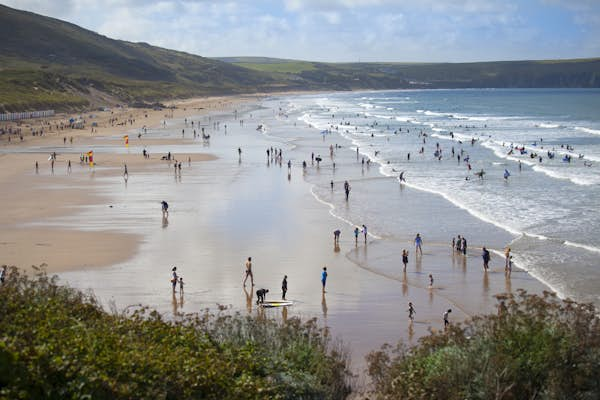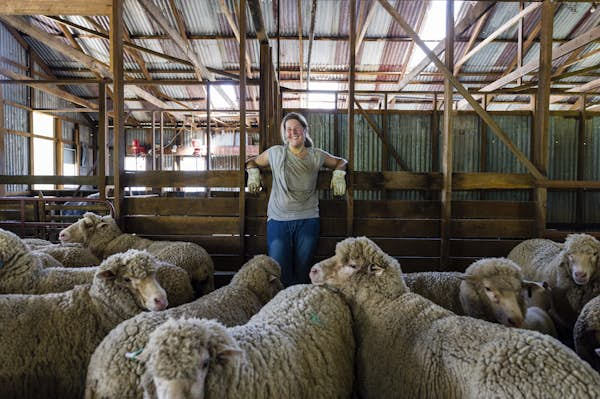This English beauty spot is the UK's first World Surfing Reserve - but what does that mean?
North Devon has been named the UK's first World Surfing Reserve, meaning the beauty spot in southwestern England is now afforded extra protection from…

A 19-mile stretch of coastline in North Devon has been officially designated the UK's first World Surfing Reserve. But what does that mean?
Well, it's a boon for surfers and the environment as the designation means the beauty spot in Southwest England is now afforded extra protection from harmful coastal developments and pollution.
Want more Lonely Planet? Sign up for our newsletter today.
The north Devon coast, which already has Area of Outstanding Natural Beauty protection, joins the likes of Australia's Gold Coast and California's Malibu and Santa Cruz as one of the 12 officially designated World Surfing Reserves.
The designation means that groups including UNESCO, local charities like Surfers Against Sewage, community groups, surf clubs, and businesses will work together to protect the 18.6 miles (30km) coastline.
"Our core focus is looking after the quality of the waves themselves and preserving the ecosystems that produce them," said Adam Hall, a local surfer and co-founder of the Surfing Reserve in North Devon. “Surf spots need to be celebrated, recognized and protected in the same way we protect and recognize beautiful national parks like Exmoor.”
The designation will protect North Devon against harmful coastal development and pollution ©Susan Walker/Getty ImagesThe designation is the first of its kind in the UK, and only the second in Europe after Ericeira in Portugal was named a WSR in 2011. The aim is to protect waves and the established surfing culture in North Devon and give the surfing community a voice in the decision-making process - allowing them to challenge threats such as harmful coastal development, reduced water quality and pollution, limited coastal access, the impacts of climate change, and any other factors that could threaten its delicate ecosystems.
“This stretch of surf ecosystems in North Devon perfectly represents what the World Surfing Reserves program works to protect,” said Trent Hodges, the Conservation Programs Manager at Save The Waves. “But WSRs are about more than collection of surf breaks. This program is about passionate surfers who step up and rally their communities to look after the places they love and be a voice for the waves.”
North Devon caters to a variety of surfing skills and abilities © Getty Images/EyeEmWhere to surf in North Devon
The UK is blessed with rugged and beautiful coastlines and more than enough swells to satisfy surfers, particularly in the Southwest corner where people flock to Devon and Cornwall for year-long curling tides that suit all levels from beginners to experts.
North Devon is one of the UK's most revered surfing spots and is home to the Museum of British Surfing and Surfing England, the national organization for surfing in England. A variety of surf schools and tutors offer lessons and equipment hire along the coastline. And you'll find that all abilities and surfing styles are catered to here, though the best breaks can be found at Croyde and Saunton beaches and the family-favorites (and beginner-friendly) Woolacombe and Puttsborough coasts. Lynmouth is also a great spot, though its waves are best suited to advanced-level surfers.
"Whether you are a surfer or a wild swimmer, surf lifesaver, stand-up paddle boarder, or just enjoying a walk along the wild coastal path, this beautiful, raw and rugged coastline intertwined with world-class surfing and waves has something for everyone," said Yvette Curtis, who founded the Wave Wahines surf and fitness club in Croyde.
You'll also find plenty of accommodation along the North Devon coast from hotels to glamping sites and bed-and-breakfasts in cozy local cottages.
When is the best time to surf in North Devon?
There are some excellent swells year-round in North Devon and the region has a temperate climate, though many of the best waves arrive in the winter season.
The coastal path to Lynmouth beach, a popular surfing spot in North Devon © Getty Images/iStockphotoDoes the World Surfing Reserve title do enough in protecting the environment?
Devon Wildife Trust said the designation is good news for people and wildlife but cautioned that seas and the entire Southwest of England continue to face serious environmental challenges and remain under threat, as it called for more wide-reaching protections.
"Overexploitation of fish stocks is causing the decline of many once-familiar species. Pollution from sewage discharge, oil spills and nutrient run-off is extremely toxic to sea life, while physical disturbance from dredging, mobile fishing gear, boat anchoring and coastal development are also taking their toll on marine habitats," a spokesperson from the Trust told Lonely Planet.
"The way to protect against these threats and restore our seas and their wildlife is to implement more and bigger Marine Protected Areas – places that these environmentally damaging activities are restricted. They are a tried and tested means of protecting habitats and wildlife at sea and there are many around the world. We urgently need more in the UK."
Where to find other World Surfing Reserves
There are 12 World Surfing Reserves including Guarda Do Embaú in Brazil; Malibu and Santa Cruz in California; Noosa Heads, Manly Beach, and the Gold Coast in Australia; Huanchaco in Peru; Punta de Lobos in Chile; Ericeira in Portugal; and Bahía Todos Santos in Mexico



















